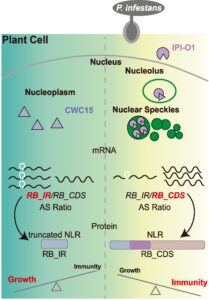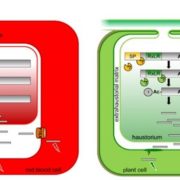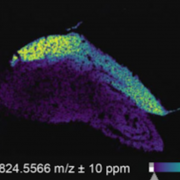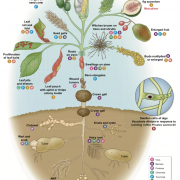Alternative splicing of a disease resistance gene maintains homeostasis between growth and immunity
 Plant resistance genes encode proteins that trigger immune responses when they recognize pathogen effectors. Their activation must be carefully regulated, as overexpression of activation of R genes usually causes a decrease in growth rate. Here, Sun et al. investigated the role of alternative splicing of a potato R gene called RB. They showed that in the absence of the Phythophtora infestans effector IPI-O1, the RB gene is spliced in such a way that an intron is retained, leading to a truncated, non-functional protein. However in the presence of the pathogen effector, the transcript is spliced to remove the intron, leading to a functional resistance protein. The authors showed that the IPI-O1 pathogen effector interacts with the plant splicing factor CWC15, causing it to localize to nuclear speckles and leading to increased splicing of the intron, functional protein production, and enhanced immunity. This finding sheds new light on how plants balance the trade-off between defense and growth. (Summary by Mary Williams @PlantTeaching) Plant Cell 10.1093/plcell/koae189
Plant resistance genes encode proteins that trigger immune responses when they recognize pathogen effectors. Their activation must be carefully regulated, as overexpression of activation of R genes usually causes a decrease in growth rate. Here, Sun et al. investigated the role of alternative splicing of a potato R gene called RB. They showed that in the absence of the Phythophtora infestans effector IPI-O1, the RB gene is spliced in such a way that an intron is retained, leading to a truncated, non-functional protein. However in the presence of the pathogen effector, the transcript is spliced to remove the intron, leading to a functional resistance protein. The authors showed that the IPI-O1 pathogen effector interacts with the plant splicing factor CWC15, causing it to localize to nuclear speckles and leading to increased splicing of the intron, functional protein production, and enhanced immunity. This finding sheds new light on how plants balance the trade-off between defense and growth. (Summary by Mary Williams @PlantTeaching) Plant Cell 10.1093/plcell/koae189









